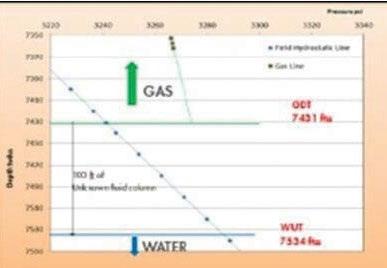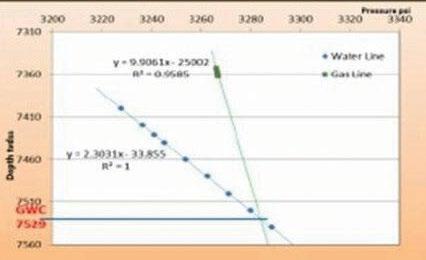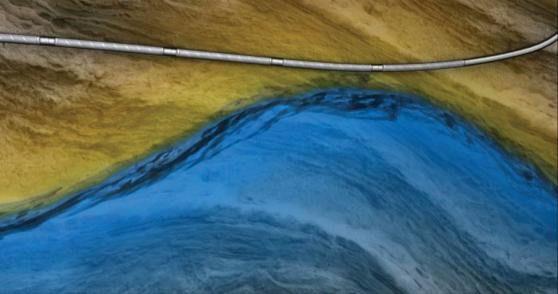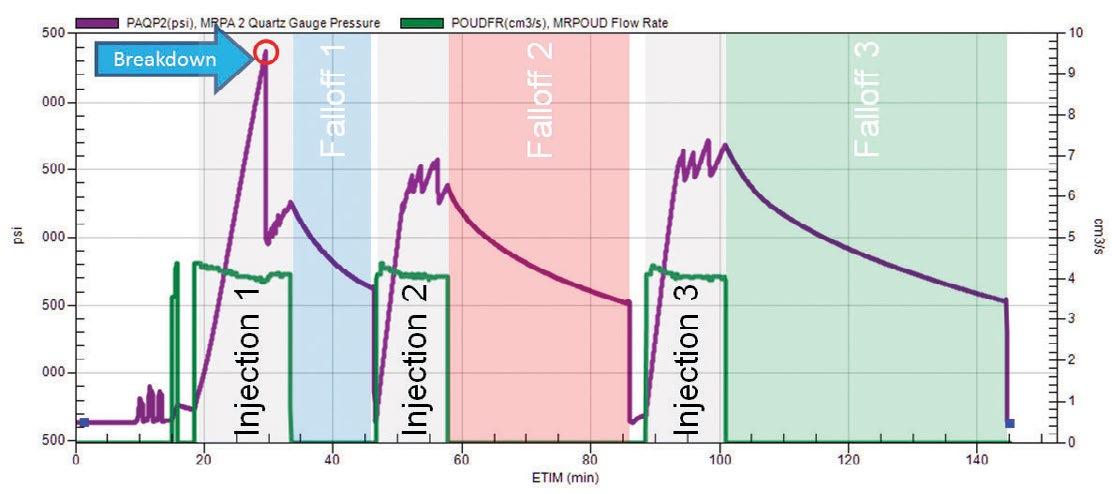
8 minute read
Young Researchers
A Fast-Tracked Development Plan of Alpha Reservoir (A Partially Appraised Field) Through Integrated Studies
Lawrence Ahiwe - Geosciences and Petroleum Engineering, University of Benin
Advertisement
Determination of the viability of a reservoir for development often requires building confidence around key decision parameters. The objective of this project is to eliminate extra costs associated with full reservoir appraisal by establishing confidence on identified uncertainties, managing, and building models to capture them. MAR A field is a green field with limited well penetrations. The objective reservoir is a relatively shallow one, with 5 well penetrations. Two of the wells are wet, while the rest penetrated hydrocarbon bearing intervals. Neutron-density logs acquired in one of the wells (MAR 15) that penetrated the hydrocarbon interval show the presence of gas. In addition, assessment of sidewall samples and ditch cuttings further validates the presence of gas in the reservoir. However, no contact has been logged from any of the wells. This, and other subsurface uncertainties, were managed with new technologies in order to achieve the aim of the project. 3D static modeling captured static uncertainties (i.e. structure, stratigraphy and rock properties) of the reservoir, following identification of limitations to reservoir development. The impact of dynamic properties on fluid recovery determined the outcome of the production forecast of the selected development concept. Impacting uncertainties in reservoir development have been managed and reduced sufficiently for development. Fluid contact uncertainty has been reduced to 20ft (from 103ft), thus eliminating presence of a producible oil rim, and managing structural uncertainty. For optimal recovery, the selected development concept targets a single well (with a pilot appraisal hole), and tubing size of 4.5”, at a rate of 50MMScf. Preliminary economic evaluations estimate a capex of $68.6m on the proposed development well, against $93.6m in a full appraisal to development scenario. The development project is viable even in the low case outcome. This study eliminates additional costs (about $25m) that would have been incurred by appraisal and fast-tracks reservoir development.
Oil and gas industry is well established as a high-cost, high-risk venture, where successes when achieved, are fulfilling. Usually, companies employ cost-cutting strategies (that do not undermine operational safety) to maintain a reasonable bottom-line and margin, especially since the current uncertainty and bust in crude prices and revenue from petroleum products. The main thrust of this work is on cost reduction techniques, focused on the pre-production phase of reservoir development.
Background of Study The reservoir under study is the Alpha reservoir, one of 16 reservoirs in a partially appraised field (MAR A field) in the Central Swamp depobelt of the Niger Delta basin, Nigeria. The MAR A field was discovered in 1971, and, up to the time of this work, was a green field. 3D seismic data has revealed the field as a fault-bounded simple roll-over structure, with a relatively low relief. It also has minor intra-field listric faults, particularly a large fault which segments the field at some levels. The focus is to fast-track the field development using current technology to delineate possible fluid contact(s) against dedicated appraisal well(s), to establish the presence or absence of an oil-rim. This in effect, will reduce costs associated with drilling more appraisal wells and building additional facilities (except flow-lines, pipelines and manifolds). As a partially appraised field, a set of uncertainties were identified for management. These include: 1. Structural uncertainty due to sparse well control. 2. Uncertainty in fluid types and depth of fluid contact.
Data Availability The MAR A field faces the challenge of sparse information and large data gaps. The field data review is enumerated below: 1. Seismic data 2. Core samples/Biostratigraphic information 3. PVT data: No fluid samples were obtained from the wells, and hence no experimental PVT data. As a result, existing correla
tions were used. 4. Pressure data
Fig. 1 - A Log Panel Showing the GDT and WUT of Alpha Reservoir
Methodology The methodology employed to fast-track reservoir development from field appraisal was that of an integrated, multi-disciplinary approach. Pressure gradient analysis is the method adopted in this study for the investigation of a possible oil rim within the objective reservoir. The theory is based on the variation in fluid gradient especially around the GOC. In testing the possibility of an oil rim in the objective reservoir column, where a gas column has been established, different possible oil gradients were plotted below the gas gradient line, against an established hydrostatic line. Different depth realizations were tested below the established Gas-Down-To (GDT) in order to evaluate the possibility of a GOC/OWC. The idea was that, should an oil rim exist within the interval of investigation, the different pressure gradients of oil and gas will establish a pressure gradient profile. For example, the oil gradient line will intersect the hydrostatic line above the Water-Up-To (WUT) line. The model was also calibrated with data from reservoirs with established GOCs.
no intersection of the oil and water lines for any of the possible oil gradients (0.2 - 0.38psi/ft). The implication is that, within the 103ft. of unknown fluid column, the maximum column of oilrim possible is just 20ft above the WUT. Even at this depth, the possible oil gradient of 0.2psi/ft. intercepts with the hydrostatic line just above the WUT line. Oil accumulation with such gradients will be very light oil. In addition, the column of possible oilrim of about 20ft. is not economical enough to be developed, so it is negligible. As a result, the gas gradient line was extended below the Gas-Down-To (GDT) to intercept the hydrostatic line at 7529 ft. This becomes the established Gas-Water-Contact (GWC), and a reference point for reservoir pressure estimation and hydrostatic initialization. With this established, the development strategy adopted was that of a gas reservoir. This can be shown in Fig. 2a and 2b respectively.

Fig. 2a - Investigation for Possible Oil-Rim Within Unknown Fluid Column
Fig. 2b - Establishment of Alpha Reservoir Contact

In-Place Volumes Due to the uncertainties in the data set used for this study, realizations were built to manage these uncertainties. As a result, low, base and high case volumes were determined to account for the possible scenarios of in-place hydrocarbon volumes. Below is a table summarizing the in-place volumes for different realizations. Table 1: Volume of Gas Initially in Place (GIIP)
LC BC HC GIPP (BSCF) GIPP (BSCF) GIPP (BSCF)
226 263 295 The gas-in-place volumes of the initialized grid model was compared to that of the static model, and the model was initialized accurately.
Development Concept Selection In a bid to determine the development concept or strategy to adopt, the following considerations were made: i. Rate of production from the reservoir. ii. Number of development well(s) to use for optimal recovery. iii. Type of well that will optimally drain the reservoir. iv. The best tubing size to use in the well. Sensitivities were carried out on various possible development concepts to understand how they will each affect the total recovery. In considering these development concepts, however, it is important to point out that the biggest constraint to the volume of hydrocarbon produced from the well at any given time is the fact that production from the well will be evacuated to a shared surface processing facility (i.e., where production from wells in other locations will also be sent). The study concluded that the optimum subsurface development concept will involve drilling one vertical development well (including pilot hole for further appraisal), completing with a 4.5-inch tubing made preferably from chrome, and an uptake rate of 50MMSCF/Day.
Production Forecast and Economics Deterministic low, base and high case subsurface realizations were built using the selected development concepts to determine the low, base and high case expected recoveries. Results are shown in table 2. Table 2: Low, Base and High Case Recoveries
LC BC
HC
Gas (BSCF) 147 170 190
RF (%) 65.8 64.6 64 Relative to the volumes initially in-place, volumes recovered from the reservoir give a recovery factor of approximately 65% for the low, base and high case scenarios.
First Pass Economics In order to demonstrate the project’s viability, we made an attempt to carry out a preliminary economic assessment. In doing this, the following assumptions were made: • Gas Price = $2/MMSCF • Well Cost (including pilot hole for appraisal) = $35M • Cost of Flow Line/Pipelines = $2.4M/Km = $33.6M • No additional facilities to be built other than pipelines and flow lines. • The fields already supplying gas to the processing facility would have entered their decline phases by the time the project comes on stream. This will create enough allege in the processing facility to accommodate production from the reservoir. Using Net Present Value (NPV) as an index of project economic performance and viability, the following values were obtained for 0% discount rate and 10% discount rate respectively. Table 3: Summary of Project Economic Assessment
NPV (0%) Discount rate
NPV (10%) Discount rate
Low Case (LC) Base Case (BC) High Case (HC)
$121M $143M $164M
$20M $26M $30M
Conclusion No substantial oil-rim was established in the reservoir. A new GWC was thus established, and the necessity of additional appraisal well(s) eliminated. The development strategy of a gas reservoir was adopted. The key impacting uncertainties are: Structure, and contact. The identified uncertainties have been managed by building realizations to adequately capture the possible outcomes. The optimum subsurface development concept is one vertical well with a 4.5-inch tubing size. Preliminary project economics evaluation show that the project is viable even in the Low-Case scenario. The project is therefore recommended for development. However, management of uncertainty around fluid type and contact, using amplitude extracted from reflectivity volume, was not possible due to poor amplitude expression on amplitude map. This does not invalidate the analysis used in this work; it would only have supported results from pressure analysis. Recommendation A C-O log should be acquired to further validate the estimated contacts and help narrow down contact uncertainties.








